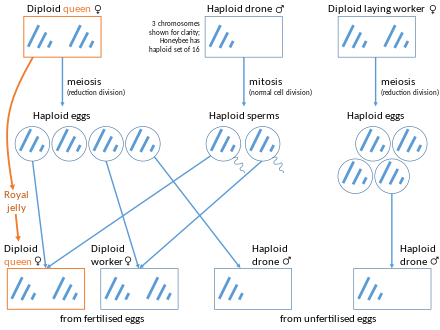Thelytoky

Thelytoky (from the
.Thelytoky can occur by different mechanisms, each of which has a different impact on the level of
Advantages of thelytoky
Species may encounter a few advantages employing this form of mating system. Thelytoky allows females to pass along genotypes that ensure success in that particular environment, having only daughters increases the species output, and energy that would otherwise be exerted into finding or attracting a mate can directly be invested in reproduction.[4]
Thelytoky can occur naturally, or it can be induced by scientists in a laboratory setting.[5] In some species, thelytoky can also occur through the fusion of two female gametes.[6]
Types of thelytoky
Facultative thelytoky refers to an individual being capable of reproducing sexually or asexually depending on environmental conditions. For example, smalltooth sawfish in Florida populations can be facultatively thelytokous, meaning that they will reproduce sexually when conditions are favorable, but switch to thelytoky when resources and mates become scarce.[7]
Accidental thelytoky occurs when a female organism produces offspring asexually due to the absence or failure of fertilization by a male. This can occur in species that normally reproduce sexually but are unable to find a mate, or in species in which mating is unsuccessful due to physical or behavioral barriers. While accidental thelytoky can provide a short-term reproductive solution in the absence of a mate, it is typically not sustainable over the long-term due to the loss of genetic diversity.[8]
Cyclical thelytoky is a form of thelytoky in which organisms alternate between sexual and asexual reproduction in a regular cycle. This type of reproduction is seen in cynipid gall wasps, in which sexual reproduction occurs in alternate generations. The asexual reproduction that occurs in between these sexual generations is typically facilitated by the presence of specific environmental cues, such as temperature or photoperiod. The genetic diversity generated by sexual reproduction in these organisms is thought to play an important role in their ability to adapt to changing environmental conditions.[9]
Obligate thelytoky refers to a form of asexual reproduction in which an individual is unable to reproduce sexually and must rely on asexual reproduction for reproduction. Species that are obligately thelytokous do not have the genetic or physiological mechanisms necessary to produce males, and thus rely solely on female offspring to perpetuate their lineage. Examples of obligately thelytokous species include some members of cerapachys ants and some species of whiptail lizards.[10]
Arrhenotoky and thelytoky in Hymenoptera

Automixis

Automixis is a form of thelytoky. In automictic parthenogenesis, meiosis takes place and diploidy is restored by fusion of first division non-sister nuclei (central fusion) or the second division sister nuclei (terminal fusion).[14] (see diagram).
With central fusion
Automixis with central fusion tends to maintain heterozygosity in the passage of the genome from mother to daughter. This form of automixis has been observed in several ant species including the desert ant
Oocytes that undergo automixis with central fusion often display a reduced rate of crossover recombination. A low rate of recombination in automictic oocytes favors maintenance of heterozygosity, and only a slow transition from heterozygosity to homozygosity over successive generations. This allows avoidance of immediate inbreeding depression. Species that display central fusion with reduced recombination include the ants P. punctata[14] and W. auropunctata,[16] the brine shrimp A. parthenogenetica,[17] and the honey bee A. m. capensis.[13] In A. m. capensis, the recombination rate during the meiosis associated with thelytokous parthenogenesis is reduced by more than 10-fold.[13] In W. auropunctata the reduction is 45-fold.[16]
Single queen colonies of the narrow headed ant Formica exsecta provide an illustrative example of the possible deleterious effects of increased homozygosity. In this ant the level of queen homozygosity is negatively associated with colony age.[19] Reduced colony survival appears to be due to decreased queen lifespan resulting from queen homozygosity and expression of deleterious recessive mutations (inbreeding depression).
With terminal fusion
Automixis with terminal fusion tends to promote homozygosity in the passage of the genome from mother to daughter. This form of automixis has been observed in the water flea
See also
References
- ISSN 0373-4137.
- ISBN 978-0-8493-5981-1.
- PMID 15523503.
- )
- S2CID 84922476.
- PMID 18716331.
- PMID 26035783.
- ISSN 0018-067X.
- ISSN 0013-8746.
- JSTOR 3891303.
- ^ S2CID 37558595.
- S2CID 1188960.
- ^ PMID 15166151.
- ^ S2CID 24645055.
- PMID 24508170.
- ^ PMID 21459760.
- ^ PMID 26356354.
- PMID 26019158.
- PMID 19127611.
- PMID 26341660.
- ^ PMID 21868391.

